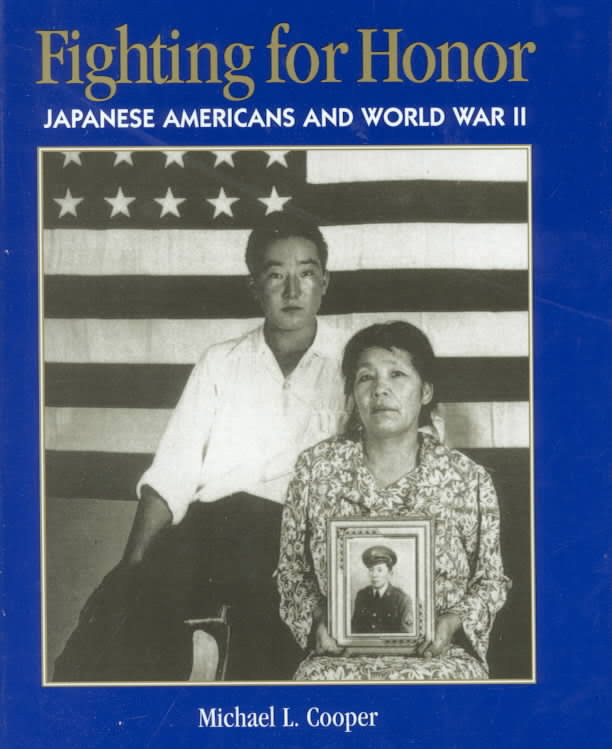Fighting for Honor: Japanese Americans and World War II (book)
Creators: Michael L. Cooper
Book aimed at middle and high school audiences on the experience of Japanese Americans during World War II, that focuses equally on the wartime incarceration and on military service.
Synopsis
Fighting for Honor is divided into nine chapters. Chapter one begins with the attack on Pearl Harbor and briefly covers the events leading to Executive Order 9066 and the forced removal of Japanese Americans. Chapter two moves back in time to cover the prewar history of Japanese Americans, the discrimination they faced, and their status just prior to the war. While chapter three looks at life in the concentration camps and chapter six at resettlement , chapters four, five, seven, and eight focus narrowly on aspects of military service: basic training of the 100th Infantry Battalion and 442nd Regimental Combat Team in chapter four; the 100th Battalion's role in the battle for Monte Cassino in Italy in early 1944 in chapter five; the October 1944 Rescue of the Lost Battalion in chapter seven; and the breaking of the Gothic Line, the Military Intelligence Service and a summary of awards in chapter eight. The final chapter covers the difficulties Japanese Americans faced after the war, but cites their ultimate triumph over time, citing the stories of Daniel Inouye and John Aiso , and ending with a lengthy passage from Farewell to Manzanar .
The book is illustrated by many photographs integrated into the text and includes a chronology and list of additional resources.
Additional Information
Author Michael L. Cooper (1950– ) was born in Kentucky and raised in a small town there. He later moved to New York to become a writer. Since 1988, he has written over fifteen books for young adults, most on aspects of American history, and many on the experiences of African Americans and other ethnic minority groups. His 2004 book Dust to Eat: Drought and Depression in the 1930s won the 2005 Golden Kite Award for best nonfiction book from the Society of Children's Book Writers and Illustrators. In addition to Fighting for Honor , Cooper also authored Remembering Manzanar: Life in a Japanese Relocation Camp (2002) for Clarion Books.
Fighting for Honor is marred by many historical errors both major and minor. The most significant of these are misstatements about the impact and significance of the alien land laws , unrest in the concentration camps and the role of the loyalty questionnaire , and the origins of the 100th Battalion. On the land laws, Cooper claims in two places that they "prohibited people who were not U.S. citizens from owning property in the state" (page 19; also 105). In fact, the California law—as well as laws in other states inspired by California—specifically targeted Asian Americans by using the phrase "aliens ineligible for citizenship." Aliens who were white (or black)—and thus eligible for naturalization by federal law—could own land. In chapter three, the author attributes "angry disturbances" in "late 1942"—likely the uprisings in Poston and Manzanar —to the loyalty questionnaire! (He also misdates a "violent riot" at Tule Lake as taking place in November 1942 rather than a year later, November 1943, pages 37–38.) In fact he has it backwards—the unrest in the camps at the end of 1942 further influenced the War Relocation Authority to try to separate the "loyal" and "disloyal" so that the latter could be segregated , which led to the ill-fated questionnaires in early 1943. (The author places the questionnaires in November 1942 in the chronology, page 106; this dating could be source of this error.) Finally, he seems not to realize that the original members of the 100th Battalion came from the ranks of prewar draftees and enlistees in Hawai'i in first suggesting they were made up of those who volunteered for the 442nd (45) and later, in a section about the 100th, writing that the 5,000 Nisei in the army prior to the attack on Pearl Harbor "were reassigned or discharged and sent to relocation camps" (46), suggesting he did not realize that the members of the 100th came out of that group of 5,000.
Among the other more minor errors: misspelling the names of Minoru Yasui (as "Minour," page 16 and 17) and Jim Tazoi (as "Tazio," 80; both names are misspelled the same way more than once); calling Nisei war hero Ben Kuroki "a native of Kansas" (68; Kuroki, one of the most famous Japanese Americans in the decade after the war, was the subject of a popular biography by Ralph Martin titled Boy from Nebraska ); claiming that residents of Hawai'i became American citizens in 1900 (45; of course Issei in Hawaii remained as ineligible for citizenship as their mainland counterparts); claiming that blocks consisted of fourteen barracks and that each barracks "housed 250 to 300 persons" (31; the number of barracks per block was different in the various camps, with most having twelve, thirteen or fourteen and Heart Mountain having twenty-four; in all camps but Heart Mountain, each block typically had 250 to 300 people); claiming that three were killed in the Manzanar riot (37; two were killed); claiming the first "MIS soldiers were recruited in the summer of 1943 from among the Nisei who were training at Camp Shelby" (89; 58 Nisei were students in the first Military Intelligence Service Language School when it began operations in November 1941, while others were recruited from the concentration camps in the fall of 1942).
Might also like Stanley Hayami, Nisei Son by Joanne Oppneheim; Korematsu v. United States: Japanese-American Internment by Susan Dudley Gold; Looking Like the Enemy: My Story of Imprisonment in Japanese-American Internment Camps: Young Reader's Edition by Mary Matsuda Gruenewald
| Author | Michael L. Cooper |
|---|---|
| Pages | 118 |
| Publication Date | 2000 |
For More Information
author website: http://www.michaellcooper.com/newsletter.htm .
